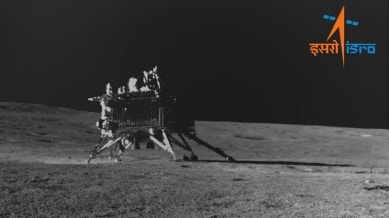The phenomenon of ‘ejecta halo’ has helped scientists understand more about the surface of the Moon

When Vikram lander of Chandrayaan-3 touched down on the Moon’s surface on August 23, it resulted in a lunar phenomenon called ‘ejecta halo.’ Scientists from the Indian Space Research Organisation (ISRO) and the National Remote Sensing Centre (NRSC) have now published a paper highlighting the significance of ‘ejecta halo’, which has helped the space agency understand more about the lunar surface.
According to a post by the ISRO on X, scientists have “estimated that about 2.06 tonnes of lunar epi regolith were ejected and displaced over an area of 108.4 m² around the landing site”. Epi regolith is nothing but the top layer of the lunar surface, which is made out of lunar rocks and soil, commonly known as moon dust.
You have exhausted your
monthly limit of free stories.
Read more stories for free
with an Express account.
Continue reading this and other premium stories with an Express subscription.
This premium article is free for now.
Register to read more free stories and access offers from partners.
Continue reading this and other premium stories with an Express subscription.
This content is exclusive for our subscribers.
Subscribe now to get unlimited access to The Indian Express exclusive and premium stories.
Most Read
The paper named ‘Characterisation of Ejecta Halo on the Lunar Surface Around Chandrayaan-3 Vikram Lander Using OHRC Imagery’, published by Swati Singh, Prakash Chauhan, Priyom Roy, Tapas R Martha and Iswar C Das in Journal of the Indian Society of Remote Sensing indicates that ‘ejecta halo’ was created due to descent stage thrusters and the consequent landing of Vikram lander.
Scientists have compared the “pre- and post-landing high-resolution panchromatic imagery from Orbiter High-Resolution Camera (OHRC) of the Chandrayaan-2 orbiter,” from before and after landing to understand ‘ejecta halo’, which looks like an “irregular bright patch surrounding the lander”.
The success of the Chandrayaan-3 mission made India the fourth country to land on the Moon. As a part of this mission, Vikram Lander and Pragyan Rover conducted many scientific explorations, which included the detection of minor elements and more. Vikram Lander achieved a milestone with its ‘hop experiment’ and finally went to sleep on September 2.
© IE Online Media Services Pvt Ltd
First published on: 29-10-2023 at 11:42 IST





